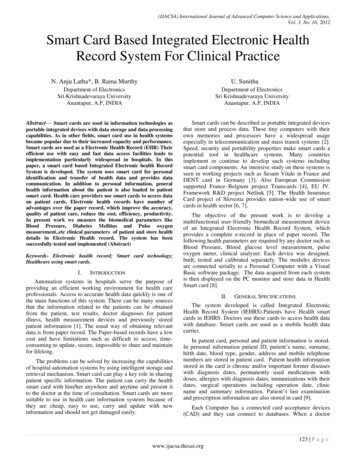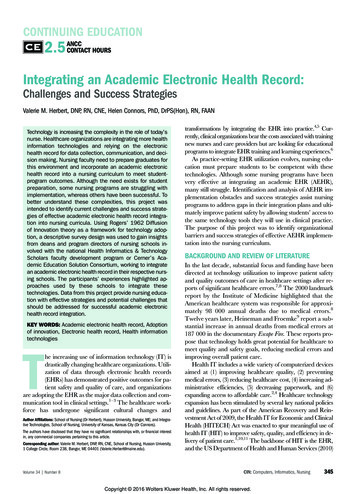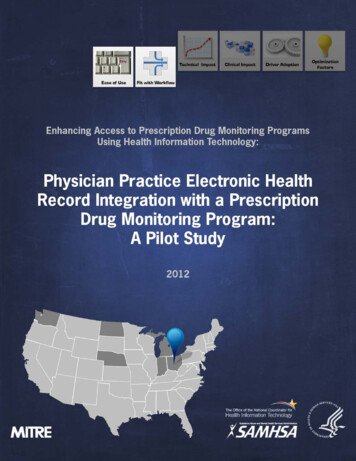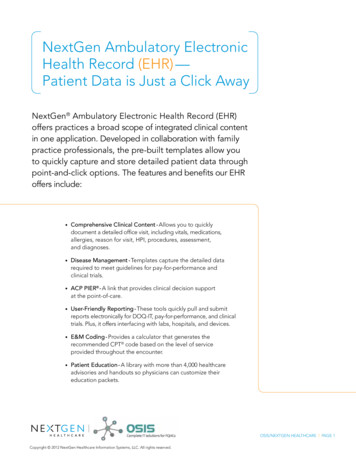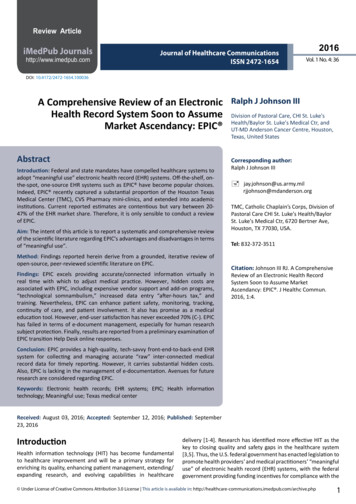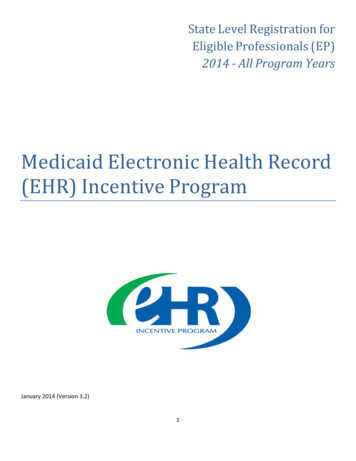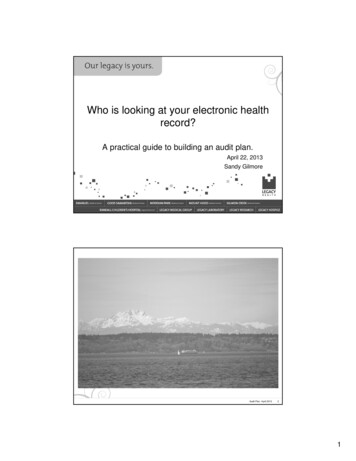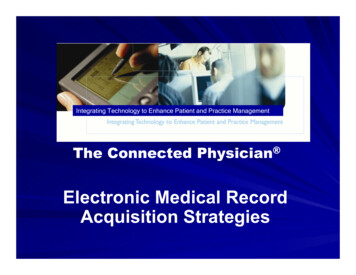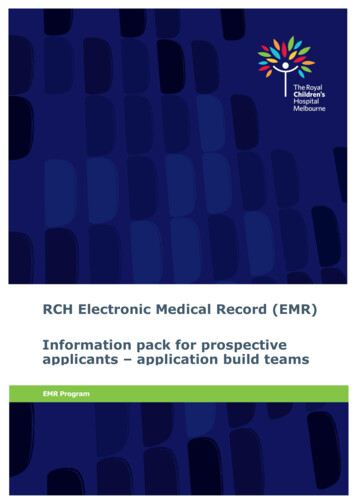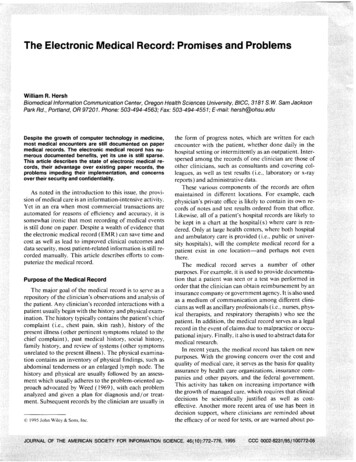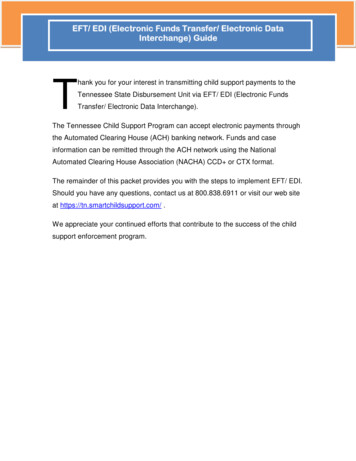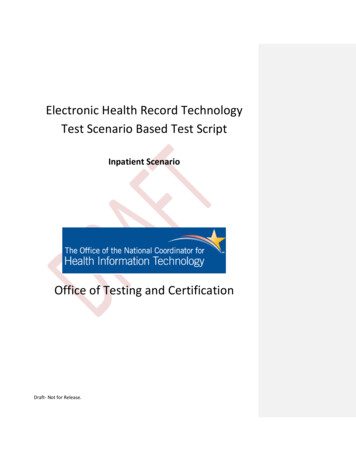
Transcription
Electronic Health Record TechnologyTest Scenario Based Test ScriptInpatient ScenarioOffice of Testing and CertificationDraft- Not for Release.
Version1.01.1Date7/16/127/23/12Draft- Not for Release.Status/ChangesInitial DraftIWG Updates(Note: this scenario will be discussedduring the 7/25/12 IWG meeting)2AuthorsC.P. BrancatoL. McCue
Scenario Based Test Case ScriptPurpose:The purpose of the scenario based test script is to test the Electronic Health Record in a manner thatreflects a typical clinical workflow to ensure that as the required data is collected, is remains “threaded”meaning pertinent and persistent throughout the entirety of each certification criterion tested.By way of example:If information is collected and appears on a patient’s problem list (170.302.(c); Maintain an up-to-dateproblem list), it is expected that the same information will be available and used by the EHR to generatea patient reminder list (170.304(d); Patient Reminders). It is expected that the vendor demonstrate a“one-to-one” match using the test data contained in the EHR that is being tested.The scenario is not intended to be an exact reproduction of any one provider’s clinical workflow. It isrecognized that clinical work flows are highly personal and unique for each medical practice.Test Methodology:Testing is performed in a sequence of iterative steps to completed one after another to match theworkflow described. At the end of the sequence and scenario, the EHR would have demonstrated itsability to perform to both the scenario sequence and the individual certification criteria tested duringthat scenario sequence.The scenario based testing sequence will assume that: The person accessing the system is the person authorized to perform the specified action to betested in accordance with the certification criteria contained in the Final Rule regardless ifvendor or test lab personnel are accessing the system. E.g., for electronic prescribing, the actorwill assume the rule of the Eligible Provider authorized to perform that function. The softwarebeing tested must be able to demonstrate that the appropriate rights and permissions areafforded to the user based on their role.The actor must complete both the entire sequence and the specific test procedure for thecriterion being tested in order to complete the test.Pre-conditions:This scenario is a typical workflow that occurs at an Eligible Providers site of care. There are a variety ofactors and interactions throughout the sequence.Draft- Not for Release.3
Certification Criteria Tested:(For example only. This to be updated to Stage 2 criteria and test procedures, when final)The scenario will test the following certification criteria:CertificationCriterion Citation170.302(a)Criterion DescriptionURL to Criterion Test Procedure170.302(b)Drug-Drug, Drug-allergyinteraction checksDrug Formulary Checks170.302(c)Maintain up-to-date problem list170.302(d)Maintain Active Medication List1703.302(e)170.302(f)(1)Maintain Active MedicationAllergy ListVital Signs170.314(a)(9)Electronic Note170.302(g)Smoking Status170.302(h)Incorporate Lab Results170.302(i)Generate Patient List170.302(j)Medication Reconciliation170.302(m)170.302(o)Patient Specific EducationResourcesAccess Control1703.302(q)Automatic Log Off170.302(t)Authentication170.304(e)Electronic Prescribing170.304(c)Record Demographics170.304(e)Clinical Decision Support170.306(d)(1)Electronic Copy of HealthInformationExchange of clinical informationand patient summary record170.304(f)Draft- Not for Release.4http://healthcare.nist.gov/docs/170.302.a DrugDrugDrugAllergy v1.0.pdfhttp://healthcare.nist.gov/docs/170.302.b DrugFormularyChecks v1.0.pdfhttp://healthcare.nist.gov/docs/170.302.c problemlist v1.0.pdfhttp://healthcare.nist.gov/docs/170.302.e allergylist v1.0.pdfhttp://healthcare.nist.gov/docs/170.302.e allergylist 1 vitalsigns .g smokingstatus v1.0.pdfhttp://healthcare.nist.gov/docs/170.302.h IncorpLabTest v1.0.pdfhttp://healthcare.nist.gov/docs/170.302.i GeneratePatientLists v1.0.pdfhttp://healthcare.nist.gov/docs/170.302.j %20MedicationReconciliation v1.0.pdfhttp://healthcare.nist.gov/docs/170.302.m EducationResources v1.0.pdfhttp://healthcare.nist.gov/docs/170.302.o AccessControl v1.0.pdfhttp://healthcare.nist.gov/docs/170.302.q AutomaticLogOff v1.0.pdfhttp://healthcare.nist.gov/docs/170.302.t Authentication v1.0.pdfhttp://healthcare.nist.gov/docs/170.304.b ExchangePrescriptionInformation v1.0.pdfhttp://healthcare.nist.gov/docs/170.304.c RecordDemographicsAmb v1.0.pdfhttp://healthcare.nist.gov/docs/170.304.e ClinicalDecisionSupportAmb 1 ElectronicCopyOfHealthInformation v1.0.pdfhttp://healthcare.nist.gov/docs/170.306.f ExchangeClinicalinfoSummaryRecordIP v1.0.pdf
170.306(h)Advance directives170.314(a)(17)Electronic MedicationAdministration record (eMAR)Clinical InformationReconciliationTransmission of electroniclaboratory tests andvalues/results to ambulatoryprovidersView, Download and transmit to3rd PartyComputerized Provider OrderEntryImagingFamily Health HistoryTransitions of 4(b)(2)170.314(b)(5)170.314(b)(6)Incorporate lab tests andvalues/resultsTransmission of electroniclaboratory tests andvalues/results to /170.306.h AdvDirectives s/170.306.a CPOEIP v1.1.pdfTBDTBDTBDTBDTBDScenario Assumptions:{Note: the inpatient scenario could theoretically be threaded from outputs from an outpatient testscenario sequence. Must consider the feasibility of running a long and possibility redundant testsequence across multiple systems}The site of service is a typical Critical Access Hospital (CAH). The CAH has applied for EHR incentive fundsand has installed or is using a certified EHR product.The users of the system include: Administrative personnelNon-licensed clinical personnelLicensed eligible providers as defined by the CMS EHR Incentive Program, Interim Final RuleThe adult patient is to be admitted to a typical general medicine acute care unit through the hospitalsregistration office, not the Emergency Department, for general signs and symptoms requiring inpatientadmission for evaluation leading to diagnosis and treatment.The scenario will follow the patient through a variety of care settings within the hospital as they arecared for by numerous providers within the hospital until discharge to home.Draft- Not for Release.5Comment [EM1]: [J. Heyman] Generally, CAHsdo not have hospitalists.
Work Flow:This scenario assumes a work flow that is categorized in three iterative phases: admission, evaluationand treatment and discharge from the hospital. In each phase, personnel will use the EHR to collect,reconcile and report clinical information the details of which are included in each of the specific testprocedures associated with the clinical scharge Advanced Directives Demographics Computerized Order Entry Drug-Drug, Drug-Allergy Interaction Checks Demographics Vital Signs, Body Mass Index and Growth Charts Problem List Medication List Medication Allergy List Clinical Decision Support Electronic Notes Drug Formulary Checks Smoking Status Imaging Family Health History Electronic Medication Adminstration (eMAR) Transistions of Care Electronic Prescribing Clinical Information Reconcilation Incorporate lab tests and values/results Transmission of electronic laboratory tests and values/results to ambulatoryprovider Transitions of Care Patient-specific education resources Calcuate and Submit Clinical Quality MeasuresAdmissions Scenario:Upon the order of a primary care physician, the patient is admitted to the hospital with symptoms whichappear to be related to adult onset Diabetes. The provider has provided the following information to thehospital: Past medical history to include problems, treatments, illnesses and surgeries.General health history to include smoking statusDraft- Not for Release.6
Family medical historyList of implantable or external medical devices, if anyAn active medication list/inventory which include medications the patient is currentlyprescribed by the provider as well as medications prescribed by other providers, if any. The listmay include response and efficacy to treatment.A past medication history to include mediations that the patient is no longer taking, hasdiscontinued on their own or on medical advice, effects and side-effects.Know drug, food or environmental allergiesConsents, power of attorney, and advanced directivesThis information is carried with the patient until they are admitted to the nursing unit.Upon arrival at the admissions office, the administrative person at the window provides the patient withforms to fill out which include demographic information to include name, date of birth, preferredlanguage, gender and with the patient’s permission, race and ethnicity in addition to other information.The admissions person asks to see some form of identification and an insurance card, if the patient hasinsurance. In this scenario, the patient provides a current Medicare card. The information from thesesources is entered into the admissions software application and is automatically imported into thehospital’s Certified EHR for clinical use. Two hospital identification bands are provided and placed on thepatient. A patient transportation person arrives to transport the patient to the patient care unit. Theemployee identifies the patient using both the paperwork they are provided by the admissions andperform a visual match to the identification band to ensure they are transporting the correct patient.Evaluation, Diagnosis and Treatment Scenario:Upon arrival at the patient care unit, the transporter provides information to the unit administrativeperson who reviews it. The nurse in charge of the unit has assigned the patient a room before thepatient arrives and the unit administrative coordinator directs the transporter to that room whilenotifying the nurse who will care for that patient for the rest of the shift.The nurse identifies the patient using the same technique the transporter used to ensure the correctpatient is being cared for and begins to the nursing assessment.Before admission, the referring provider has electronically transmitted a comprehensive summary ofcare record which was imported into the hospital’s EHR. The nurse verifies the information during herassessment and reconciles any discrepancies using the functionality available in the EHR.During the nursing assessment, the nurse collects the following information: As part of the nursing assessment, the nurse reviews with the patient the information providedby the referring physician which includes:o Past medical history to include problems, treatments, illnesses and surgeries.o General health history to include smoking statusDraft- Not for Release.7Comment [EM2]: [J. Heyman] I would assumethat the outpatient referring physician is likely to bethe same physician caring for the patient as aninpatient. This would be true for any surgical orobstetrical patient and more likely for a medicalpatient.Comment [EM3]: [J. Heyman] In any of thesescenarios, the note is much more valuable than theCCR as it appears to imply in the bulleted list thenurse is using on admission.Comment [EM4]: [J. Heyman] The physician whosends the patient to the hospital for admission islikely to have done the history and physical (H&P) inhis/her office.
Family medical historyList of implantable or external medical devices, if anyAn active medication list/inventory which include medications the patient is currentlyprescribed by the provider as well as medications prescribed by other providers, if any.The list may include response and efficacy to treatment.o A past medication history to include mediations that the patient is no longer taking, hasdiscontinued on their own or on medical advice, effects and side-effects.o Know drug, food or environmental allergieso Consents, power of attorney, and advanced directivesPsycho-social evaluationPhysical exam to include:o Vitals signs to include, at minimum, height, weight, and blood pressure.ooo Comment [EM5]: [J. Heyman] It is one thing if anEMR keeps a list of all previous meds entered, but Iknow few physicians who ask a Medicare patient totell them all the medications he/she can rememberusing in the past.After completing the nursing assessment, the nurse inputs the information gathered from the patient,the referring physician and the nursing assessment into the EHR. The nurse activates any standing ordersets using the Computerized Provider Order Entry functionality as per the hospital protocols.The nurse contacts the physician that the patient has arrived on the unit and if there are any additionalorders at this time. The physician relays a verbal order to the nurse and prescribes all the medicationsthat the patient uses to maintain their health and wellness while outside the hospital. The nurse entersthose orders into the EHR.The physician arrives shortly to see the patient and reviews the information from both the nurse and thereferring physician with the patient. After review, the physician performs a physical exam which includesa review of all physical systems of the patient.Once completed, the physician enters in his clinical note into the EHR and activates the Clinical DecisionSupport functionality contained in the EHR then selects the national clinical guideline for Diabetes andperforms the following based on the guideline recommendations: Discontinued several medications, adjusted the dose and route of administration of severalothers establishing new orders for several others.o The EHR automatically checks the following and alerts the provider if: The patient has a known allergy to the medications ordered Is already on the medication in some form The medication would have interactions with other drugs and could possiblycause harm to the patient The dosage and route of administration are incorrect against accepted practice The medication is not currently on the hospital’s drug formulary.Orders a panel of laboratory testsOrders several tests to be performed by the Radiology Department.Orders a consult for the Endocrinology specialist to evaluate the patient for Diabetes.Enters dietary, activities of daily living and other restrictionsDraft- Not for Release.8Comment [EM6]: [J. Heyman] The physicianmight dictate the note from his/her office to thehospital over the phone, or could electronically sendthe note or fax it.
The nurse who is caring for the patient accesses the EHR and reviews the orders and acts upon them asappropriate while documenting in the EHR that the order has been received and completed.Through the EHR, the laboratory technician receives the order to take the blood samples required forthe laboratory tests the physician ordered. Once the samples are evaluated and the data is importedinto the Laboratory Information System, it is exported and made available to the hospital’s EHR.As medications arrive on the nursing unit, the nurse reviews the medication administration schedule forthe patient and administers the medication per the physician order. Before administering, the nurseperforms the following: Identifies the patient as per hospital protocolVerifies that the medication is identified for the patient and that the medication matches theoriginal orderVerifies that the dose matches the medication orderVerifies the route of administration matches the order.After performing these checks, the medication is administered and recorded as such in the EHR.Both the hospital laboratory and radiology systems have provided the test results and interpretations tothe hospital’s EHR.The Endocrinologist received the consult through the EHR evaluates the patient, reviews both thelaboratory results and radiographic interpretations and documents an electronic note in the EHR andproceeds to adjust the patient’s medication orders and recommends the patient be discharged from thehospital to home the following day.Discharge:The provider orders that the hospital’s diabetes educator see the patient and provide the appropriateeducational materials before the patient is discharged. The educator uses the EHR to search for on lineeducational material selected by information contained in the EHR.Once the patient is discharged from the hospital and final charting has been completed, the hospital’sEHR generates and sends a “summary of care record” to the referring provider.Draft- Not for Release.9
obstetrical patient and more likely for a medical patient. Comment [EM3]: [J. Heyman] In any of these scenarios, the note is much more valuable than the CCR as it appears to imply in the bulleted list the nurse is using on admission. Comment [EM4]: [J. Heyman] The physician who sends the patient to the hospital for admission is

